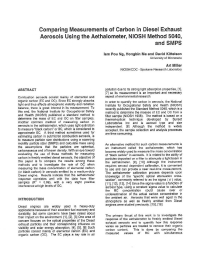 |
Combustion aerosols consist mainly of elemental and organic carbon (EC and OC). Since EC strongly absorbs light and thus affects atmospheric visibility and radiation balance, there is great interest in its measurement. To this end, the National Institute for Occupational Safety and Health (NIOSH) published a standard method to determine the mass of EC and OC on filter samples. Another common method of measuring carbon in aerosols is the aethalometer, which uses light extinction to measure "black carbon" or BC, which is considered to approximate EC. A third method sometimes used for estimating carbon in submicron combustion aerosols, is to measure particle size distributions using a scanning mobility particle sizer (SMPS) and calculate mass using the assumptions that the particles are spherical, carbonaceous and of known density. With an eye toward evaluating the use of these methods for measuring carbon in freshly emitted diesel aerosols, the objective of this paper is to compare the results among these methods and to investigate the role of OC when measuring the mass concentration of elemental carbon (or black carbon) in aerosols emitted by a medium-duty Diesel engine. Results indicate that the aethalometer response correlates well with the data from filter samples (R2 = 0.99), with a very slight positive interference at high levels of OC.
| Author(s): | Ng-IP, Ma-H, Kittelson-DB, Miller-AL |
| Reference: | SAE Technical Paper Series 2007-01-0334, 2007 Apr :1-10 |
cmoci (PDF, 2673 KB) (image based PDF - not searchable)
